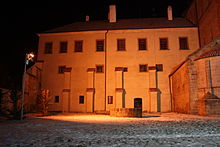- Territorial abbey
-
 The coat of arms of a territorial abbot are distinguished by a green galero with twelve tassels and a gold crozier with a veil attached.
The coat of arms of a territorial abbot are distinguished by a green galero with twelve tassels and a gold crozier with a veil attached.
A territorial abbey (or territorial abbacy) is a type of particular church within the Roman Catholic Church.
Normally an abbot is the superior of an abbey (a monastery), and exercises authority over a religious family of monks. His authority extends only as far as the monastery's walls, or only to the monks who have taken their vows in his monastery. A territorial abbot - also called an abbot nullius diœceseos, Latin "belonging to no diocese", or abbreviated abbot nullius - functions additionally as the ecclesiastical ordinary for the Catholics and parishes within a defined territory around the monastery, in much the same way a bishop does for a diocese.
The practice arose in part because abbeys served the spiritual needs of Catholics who lived near the monastery, especially in mission territories. The monastery's own chapel was a space of public worship for the laity who had settled nearby, and the monks could also serve as parish clergy in churches near the monastery. The abbot of the monastery, although having received only the priesthood in the sacrament of Holy Orders, was invested with the same administrative authority under canon law as a diocesan bishop for a given territory around the abbey. Thus, with the exception of conferring ordination on priests, the abbot could do almost everything a diocesan bishop would for those under his care, including incardinate (that is, enroll under his jurisdiction) even non-monastic priests and deacons for service in parishes.
Though territorial (like other) abbots are elected by the monks of their abbey, a territorial abbot can only receive the abbatial blessing and be installed under mandate from the pope, just as a bishop cannot be ordained and installed as ordinary of a diocese without such a mandate.
After the Second Vatican Council, more emphasis has been placed on the unique nature of the episcopacy and on the traditional organization of the church into dioceses under bishops. As such, abbeys nullius have been phased out in favor of the erection of new dioceses or the absorption of the territory into an existing diocese. A few ancient abbeys nullius still exist in Europe, and one in Korea.
List of territorial abbeys
There are 11 remaining territorial abbeys, as listed in the Annuario Pontificio of the Vatican:
- Maria Einsiedeln, Switzerland
- Montecassino, Italy
- Monte Oliveto Maggiore, Italy
- Montevergine, Italy
- Pannonhalma, Hungary
- Saint-Maurice, Switzerland
- Santa Maria di Grottaferrata, Italy
- Santissima Trinità di Cava de' Tirreni, Italy
- Subiaco, Italy
- Tŏkwon/Deokwon/덕원, North Korea
- Ecclesiastically united with South Korea, Tŏkwon had been vacant for over fifty years until 2005, when Fr. Francis Ri was appointed as the abbot. It has not been united with any diocese in either South Korea or North Korea due to the effective vacancy of the ones in North Korea and the lack of effective jurisdiction applied by the South Korean church.
- Wettingen-Mehrerau Abbey, Austria
In Italy the following abbeys have been united with a diocese:
- Farfa (united with the Diocese of Sabina–Poggio Mirteto) in Italy
- Fontevivo (united with the Diocese of Parma)
- Pomposa (united with the Archdiocese of Ferrara–Comacchio)
- San Columbano (united with the Piacenza–Bobbio)
- San Martino al Monte Cimino (united with the Diocese of Viterbo)
- San Michele Arcangelo di Montescaglioso (united with the Archdiocese of Matera–Irsina)
- San Salvatore Maggiore (united with the Diocese of Rieti)
- Santa Maria di Polsi (united with the Diocese of Locri–Gerace)
- Santissimo Salvatore (united with the Archdiocese of Messina-Lipari-Santa Lucia del Mela)
In other European countries:
- Cluny (in Burgundy; now united with the Diocese of Autun) is the only one in France. Historically Cluny was the mother house of the Congregation of Cluny as a result of the Cluniac monastic reform of the 11th century, primarily in that it removed many Benedictine abbeys under its jurisdiction from local feudal allegiances (hence establishing their independence) and had new ones founded. It became extremely rich and influential within and beyond the Church.
 Abbacy of St Procopius' Basilica in Třebíč.
Abbacy of St Procopius' Basilica in Třebíč.
Historically there have been more, such as
- St. Peter-Muenster,[1] which from 1921 until 1998 served a remote area of Saskatchewan, Canada (the abbey still exists, but its territorial jurisdiction and duties were absorbed by the Diocese of Saskatoon).
- St. Alexander Orosci, enclaved in the Albanian Diocese of Alessio
- Pinerolo, a prince-abbacy in Piedmont later transformed into a bishopric.
- Abbey of Saint Paul Outside the Walls in Rome (jurisdiction passed to a newly named archpriest in 2005).
- Belmont Abbey - Mary, Help of Christians, which was the territorial abbey of half of North Carolina from 1910 until 1960, when it lost its last extra-abbatial territory. It was formally suppressed as a territorial abbey in 1977.[2]
Sources and references
- ^ Cheney, David M. (2007), "Territorial Abbey of Saint Peter-Muenster", Catholic-Hierarchy.org, http://www.catholic-hierarchy.org/diocese/ds005.html, retrieved 2007-08-17
- ^ Catholic-hierarchy.org
 "Abbot". Catholic Encyclopedia. New York: Robert Appleton Company. 1913.
"Abbot". Catholic Encyclopedia. New York: Robert Appleton Company. 1913.
External links
- List of Current Territorial Abbacies by Giga-Catholic Information
- Attribution
 This article incorporates text from a publication now in the public domain: Herbermann, Charles, ed (1913). Catholic Encyclopedia. Robert Appleton Company. passimCategories:
This article incorporates text from a publication now in the public domain: Herbermann, Charles, ed (1913). Catholic Encyclopedia. Robert Appleton Company. passimCategories:- Ecclesiastical titles
- Organisation of Catholic religious orders
- Roman Catholic Territorial Prelates
Wikimedia Foundation. 2010.
